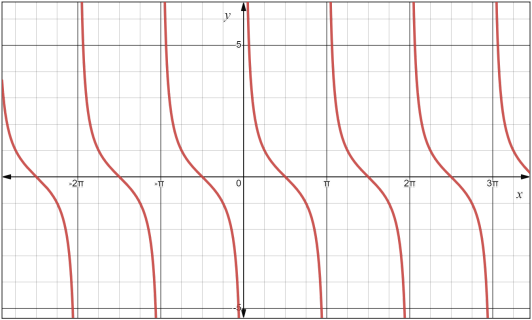
The function f x = cot x
The function
Given information:
The function
Explanation:
Consider the function
It can be written as
As the function
The domain of
Graph the function.

The graph is continuous on the domain and the function is decreasing on the domain.
Also,
So, this is an odd function.
The graph is also symmetric with respect to origin.
As the range of function is
The graph has vertical asymptotes where the sine function has zeroes. So, vertical asymptotes are the integer multiples of
As the function
Thus, the function
Chapter 4 Solutions
PRECALCULUS:GRAPH...-NASTA ED.(FLORIDA)
- Calculus lll May I please have the solution for the following exercise? Thank youarrow_forward2z = el+cos(x+y) 24 = olt etz dy = 1 dt dz e²² + cos (+²+1++). 2++ (1+++cos C+²+1++) (+) dz 2+. etz 2t, + 2+⋅ cos (t² +++ 1) + t (1++1 dt + cos (+²+++1) 2. W= (yz) (yz) x x=e8++ 2 y= 3² + 3st, z=sent, hallar 2w 2w د 2u 2t 25 2t AX119 S Narrow_forwardpractice for test please help!arrow_forward
- practice for test please help!arrow_forwardX MAT21 X MindTa X A 26308 X Answer X M9 | C X 10 EKU-- × E DNA S X H. pyle x C static/nb/ui/evo/index.html?elSBN=9780357038406&id=339416021&snapshotld=877369& CENGAGE MINDTAP nctions, Limits, and the Derivative In Exercises 15, 16, 17, 18, 19, and 20, refer to the graph of the function f and determine whether each statement is true or false. -3-2-1 4- 3+ y= f(x) 2 1+ x 1 2 3 4 5 6 AA aarrow_forwardex MAT21 X MindTa X A 26308 X Home X M9|C X 10 EKU-- × E DNA S X H. pylo x C Ch om/static/nb/ui/evo/index.html?elSBN 9780357038406&id=339416021&snapshotld=877369& CENGAGE MINDTAP : Functions, Limits, and the Derivative E 3 In Exercises 21, 22, 23, 24, 25, 26, 27, 28, 29, 30, 31, 32, 33, 34, 35, 36, 37, and 38, find the indicated one-sided limit, if it exists. 21. lim (2x+4) x+1+ Answer 22. lim (3x-4) x-1 23. lim x-3 x+2x+2 Answer 24. lim x+2 x1+x+1 1 25. lim x+0+ x Answer▾ 26. lim 1 x40X x-1 27. lim x+0+ x²+1 Answer 28. lim x + 1 x-2+ x2 -2x+3 $ 4 % 5 MacBook Pro A 6 27 & * ( 8 9 AA a searrow_forward
- 1. 2. In Exercises 1, 2, 3, 4, 5, 6, 7, and 8, use the graph of the function f to find lim f(x), lim f(x), and xa x+a+ lim f(x) at the indicated value of a, if the limit exists. x a Answ 2: the init X1starrow_forward1. 2. In Exercises 1, 2, 3, 4, 5, 6, 7, and 8, use the graph of the function f to find lim f(x), lim f (x), and xa x→a+ lim f (x) at the indicated value of a, if the limit exists. xa Ans 2: the lin X1st S 4+ 3 y = f(x) 2 1 2 3 4 5 6 a=3arrow_forward1. 2. In Exercises 1, 2, 3, 4, 5, 6, 7, and 8, use the graph of the function f to find lim f(x), lim f(x), and xa x+a+ lim f(x) at the indicated value of a, if the limit exists. x a Answ 2: the init X1starrow_forward
- Chrome File Edit View History Bookmarks TC MyTCC: Studer × ALTI Launch ✓ Profiles Tab Window Help O Tue Mar 25 12:42 AM Pearson MyLak × P Course Home ✓ MasteringChen X Use the orbital × | My Uploads | b x Phosphorus El x + session.chemistry-mastering.pearson.com/myct/itemView?assignmentProblemID=234894331 A New Chrome available : (? Helparrow_forwardPlease find the open intervals where the functions are concave upward or concave downward. Find any inflection points also thanks!Note: This is a practice problem!arrow_forwardUse the graph below to evaluate each limit. -11 -10 -9 -8 -6 -5 -- + -0.3 -3 -2 -0.2 -0.1- ▼ 0 1 2 -0.1- -0.2- -0.3- 3. 4 5 -0 6 -0:4 -edit-graph-on- desmos lim f(x)= _9-←x lim f(x)⇒ x→1 ☐☐ lim f(x)⇒ +9-←x lim f(x)⇒ x→−4+ lim f(x)⇒ x→1+ lim f(x)= x→2+ lim f(x)⇒ x→-4 lim f(x)⇒ x→2arrow_forwardarrow_back_iosSEE MORE QUESTIONSarrow_forward_ios
 Calculus: Early TranscendentalsCalculusISBN:9781285741550Author:James StewartPublisher:Cengage Learning
Calculus: Early TranscendentalsCalculusISBN:9781285741550Author:James StewartPublisher:Cengage Learning Thomas' Calculus (14th Edition)CalculusISBN:9780134438986Author:Joel R. Hass, Christopher E. Heil, Maurice D. WeirPublisher:PEARSON
Thomas' Calculus (14th Edition)CalculusISBN:9780134438986Author:Joel R. Hass, Christopher E. Heil, Maurice D. WeirPublisher:PEARSON Calculus: Early Transcendentals (3rd Edition)CalculusISBN:9780134763644Author:William L. Briggs, Lyle Cochran, Bernard Gillett, Eric SchulzPublisher:PEARSON
Calculus: Early Transcendentals (3rd Edition)CalculusISBN:9780134763644Author:William L. Briggs, Lyle Cochran, Bernard Gillett, Eric SchulzPublisher:PEARSON Calculus: Early TranscendentalsCalculusISBN:9781319050740Author:Jon Rogawski, Colin Adams, Robert FranzosaPublisher:W. H. Freeman
Calculus: Early TranscendentalsCalculusISBN:9781319050740Author:Jon Rogawski, Colin Adams, Robert FranzosaPublisher:W. H. Freeman
 Calculus: Early Transcendental FunctionsCalculusISBN:9781337552516Author:Ron Larson, Bruce H. EdwardsPublisher:Cengage Learning
Calculus: Early Transcendental FunctionsCalculusISBN:9781337552516Author:Ron Larson, Bruce H. EdwardsPublisher:Cengage Learning





